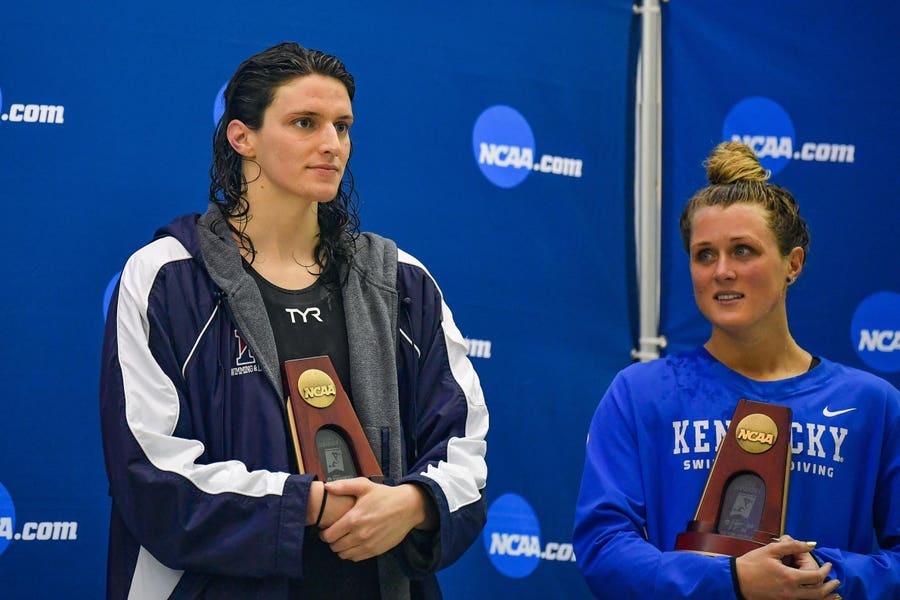
A just released January 2024 UK report on the transgender athlete in women’s sport issue features the voices of females (biological girls and women) who have experienced sports competing against transgender athletes. From grassroots recreational sport to national and international levels of competitive sport, as well as from the insides of changing rooms and rest rooms, girls and women from 35 sports are speaking out. Their voices are speaking clearly about how they are being adversely affected by policies which allow males who identify as women to compete in women’s sport.
Contrary to organizational claims “there are only a few transgender athletes” participating in girls’ and women’s sport, the subjects in this report describe a “multiplier effect” in which “hundreds of males taking part in women’s sport, are actually affecting tens of thousands of women and girls.” These voices explain that its not just about losing out on winning, records, rankings, or opportunities to participate, it’s about not being considered nor asked and even being coerced into accepting a mixed-sex environment. They speak about a climate of intimidation, fear, silencing, loss of privacy and dignity, and fear for their physical safety.
It’s important for us to listen.
To date, transgender organizations have had an impressive communications campaign — embracing the social justice values of inclusion, the importance of equal treatment, and the dangers of suicide resulting from non-identical treatment and exclusion. Impressive, but most disturbing, is how transgender organizations have effectively silenced the voices of females playing sports and anyone who has questioned their positions or representation of facts.
Both the transgender and the social justice communities have not hesitated to sling the arrows of “transphobia” to diminish respect for those who question the admission of male bodies into the previously protected women’s sport category. They have also gone several steps further, by complaining to the corporate sponsors of female athletes who speak out on the issue, or questioning the commitment of recognizable female athletes who have and still vigorously support the rights of LGBTQ individuals. This report elevates the voices of these female athletes – girls and women – which should be received with the same respect and consideration as the voices of transgender athletes.
Additionally, the report is important because it begs the question of why more people haven’t been speaking out to support women athletes who have been adversely affected. First, the evolving “language” of gender identity has been a huge barrier. Some people are simply afraid of making a language mistake. Using the wrong terms or pronouns has incited anger, accusations of transphobia, allegations of sexual harassment, and even termination of employment. Supporting the use of pronouns preferred by individuals is important, but making a language mistake should not result in such accusations or punishment.
A second reason for not speaking out in support of these girls and women appears to be lack of familiarity with or confusion about the difference between “sex” and “gender identity.” When a person understands the difference and wishes to make a scientifically accurate statement about, for instance, “a biologically male person who identifies as a woman,” an angry response ensues from transgender organizations or individuals objecting to the accurate “biologically male” descriptor and the person is accused of being disrespectful or transphobic.
If we are to engage in a conversation on the fairness or safety of transgender participation in women’s sports, it is critical to understand that “sex” and “gender identity” are not interchangeable or synonymous. We have to learn these terms in order to understand the issue and support female athletes everywhere — and specifically, the ones who have spoken out in the UK report.
Sex is a fact determined by anatomy, physiology, genetics, and hormones according to the U.S. National Institute of Health, Office of Research on Women’s Health. Sex is defined by reproductive cells. Individuals are either female with bodies designed to produce eggs, or they are male with bodies designed to produce sperm. Even individuals whose sex development is atypical, commonly termed intersex or DSD (differences of sexual development), represent 0.018% of the human population. Every cell in a human body is either XX or XY (with rare exceptions). Sex is immutable. Males cannot become female, regardless of gender identity and medical treatments; nor can females become males.
“Gender identity” on the other hand, refers to a psychological state, belief, or identity. It is described by terms such as “transwomen,” “transmen,” “gender-fluid,” “nonbinary,” and any other identity individuals may adopt. By definition, gender identity is flexible. It can change over time. Indeed, some individuals’ gender identity is to be “gender fluid”; they may declare themselves to be women one day or week, and men the next. We should be using the words female, male, girl, boy, woman, and man without a modifier to denote a person’s sex, regardless of their gender identity.
We should simply use the word transgender for individuals of either sex who call themselves trans or transgender. “Transwomen are women” is a political statement, not a fact. “Transwomen are males who think of themselves as and identify as women” is an accurate statement. We should be able to use these terms respectfully AND clarify biological facts because they matter.
The transgender communications campaign has sought to convince the public that taking hormones or surgically removing male testicles eliminates male sport performance advantage and effectively converts males to females. This is simply not true. Even after taking hormones or having surgery, male legacy advantage persists. In fact, most transgender athletes in women’s sports have made zero modifications to their male bodies and still possess vast sport performance advantages over female bodies.
According to recent research by the Washington Post and the Kaiser Family Foundation, just 31 percent of transwomen have used hormone treatments, HRT (hormone replacement therapy), or puberty-blocking hormones, and only 16 percent have undergone “gender-affirming” surgery or another surgical treatment to change their physical appearance. Because this survey was conducted on adults, we can reasonably assume that schoolchildren and college students are even less likely to have used medication or undergone surgery. Therefore, most trans-identified adults (at least 84 percent) have not had surgery, and at least 69 percent have not taken any medications. Other research confirms that most men who self-ID as women (between 87 and 96 percent) have not removed their testicles or penis.
These definitions and this research have meaning and consequences, especially as they pertain to the voices of girls and women in sport. We must understand that in all likelihood they are competing against male bodies whose superior strength, speed, and other performance advantages are unmitigated by hormones or surgery. Title IX gave permission for separate sex sport because the U.S. Congress recognized that women would not have a fair chance to even be selected for a sport team if there was only one team for men and women. Biological sex is the largest determinant of athletic performance. The male and female category distinctions must not be ignored. Science supports the voices of the girls and women in the UK report.
Postscript: Protection of the female category does not mean that transgender athletes who identify as women are excluded from sport. Regardless of gender identity, males qualify in their proper sport category based on biology, like every other male athlete. For trans-identified males who are uncomfortable playing with and against boys or men, accommodations within women’s sports could easily be developed. There could be separate scoring in individual sports, separate teams and leagues for team sports, new transgender categories, or other solutions – so long as there is no direct competition against females and no reduction of female athletes’ rights to receive their equitable percentage of all participation, scholarship, and prize-money opportunities. These are the kinds of solutions that arise from respectful conversations among people who equally care about fair and safe competition for both female and transgender athletes.



